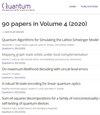Rise of conditionally clean ancillae for efficient quantum circuit constructions
IF 5.1
2区 物理与天体物理
Q1 PHYSICS, MULTIDISCIPLINARY
引用次数: 0
Abstract
We introduce conditionally clean ancilla qubits, a new quantum resource, recently explored by [17], that bridges the gap between traditional clean and dirty ancillae. Like dirty ancillae, they begin and end in an unknown state and can be borrowed from existing system qubits, avoiding the space overhead of explicit qubit allocation. Like clean ancillae, they can be treated as initialized in a known state within specific computations, thus avoiding the overhead of toggle detection required for dirty ancillae. We present new circuit constructions leveraging conditionally clean ancillae to achieve lower gate counts and depths, particularly with limited ancilla availability. Specifically, we provide constructions for:(a) $n$-controlled NOT using $2n$ Toffolis and $O(\log{n})$ depth given 2 clean ancillae.
(b) $n$-qubit incrementer using $3n$ Toffolis given $\log_2^*{n}$ clean ancillae.
(c) $n$-qubit quantum-classical comparator using $3n$ Toffolis given $\log_2^*{n}$ clean ancillae.
(d) unary iteration over $[0,N)$ using $2.5N$ Toffolis given $\log_2^*{n}$ clean ancillae.
(e) unary iteration via skew tree over $[0, N)$ using $1.25N$ Toffolis given $n$ dirty ancillae.
We also introduce $\textit{laddered toggle detection}$, a technique to replace clean ancillae with dirty ancillae in all our constructions, incurring a 2x Toffoli gate overhead. Our results demonstrate that conditionally clean ancillae are a valuable tool for quantum circuit design, especially in the resource-constrained early fault-tolerant era.
高效量子电路结构的条件清洁辅助装置的兴起
我们引入了有条件的清洁辅助量子比特,这是[17]最近探索的一种新的量子资源,它弥合了传统清洁和脏辅助之间的差距。就像肮脏的附属装置一样,它们以未知状态开始和结束,可以从现有的系统量子比特中借用,避免了显式分配量子比特的空间开销。与干净的辅助点一样,它们可以在特定计算中被视为在已知状态下初始化,从而避免了对脏辅助点所需的切换检测开销。我们提出了新的电路结构,利用有条件的清洁辅助器件来实现更低的栅极计数和深度,特别是在有限的辅助器件可用性下。具体来说,我们提供以下结构:(a) $n$-控制不使用 $2n$ 软糖和 $O(\log{n})$ 深度给予2个干净的腋窝。(b) $n$-量子位递增器使用 $3n$ 托佛利 $\log_2^*{n}$ 清洁腋毛。(c) $n$-量子比特量子经典比较器使用 $3n$ 托佛利 $\log_2^*{n}$ 清洁腋毛。(d)一元迭代结束 $[0,N)$ 使用 $2.5N$ 托佛利 $\log_2^*{n}$ 清洁腋毛。(e)斜树遍历一元迭代 $[0, N)$ 使用 $1.25N$ 托佛利 $n$ 肮脏的腋毛。我们还介绍 $\textit{laddered toggle detection}$在我们所有的结构中,用脏的辅助元件替换干净的辅助元件的技术,会产生2倍的托佛利栅格开销。我们的研究结果表明,条件清洁辅助电路是量子电路设计的一个有价值的工具,特别是在资源受限的早期容错时代。
本文章由计算机程序翻译,如有差异,请以英文原文为准。
求助全文
约1分钟内获得全文
求助全文
来源期刊

Quantum
Physics and Astronomy-Physics and Astronomy (miscellaneous)
CiteScore
9.20
自引率
10.90%
发文量
241
审稿时长
16 weeks
期刊介绍:
Quantum is an open-access peer-reviewed journal for quantum science and related fields. Quantum is non-profit and community-run: an effort by researchers and for researchers to make science more open and publishing more transparent and efficient.
 求助内容:
求助内容: 应助结果提醒方式:
应助结果提醒方式:


